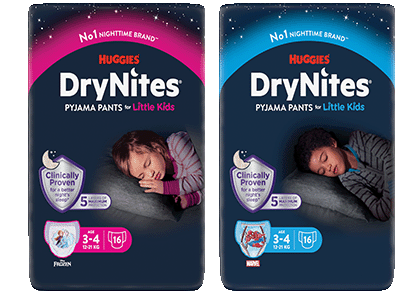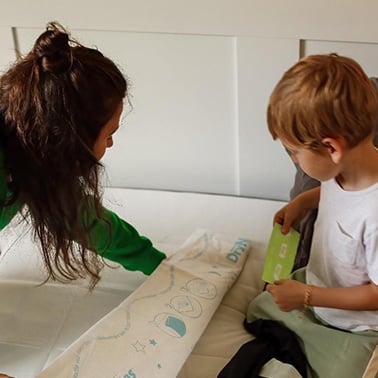But where do you start with the clean up? The first thing you’ll want to do is get all that damp clothing and sheets into a wash. Once that’s going, it’s time to deal with the mattress.
Although cleaning a mattress sounds like a tough ask—yes, we know it doesn’t fit in the washing machine—it can be simple if the right steps are followed.
Cleaning up a mattress after bedwetting: what to do first
Following a bedwetting incident your first job is to reassure your child, who is probably feeling very self-conscious, that everything is okay. Explain that it’s common in children their age—and even adults can do it occasionally. Reassure them that you’ll work through it together as a team.
Next, it’s time to start getting things clean
Get all the soiled clothes and sheets and quickly get them into the washing machine.
For sheets, aim for a temperature above 60 degrees to kill germs. If the smell is particularly strong, a little white vinegar can help neutralise odours. If you're worried about any stains, pour some hot water on the area with a little bit of detergent mixed in. After this you can wash the sheets normally.
The same principle can be applied to your little one's clothes. If you’re not worried about colour mixing, you can put them all in the wash together to save energy, water and time!
How to clean wee off your child’s mattress
Your child is calm, and the sheets are in the wash. You’re doing great! It’s now time to clean the mattress. Although urine is 95% water, the remaining portion—urea—is a waste product made in the liver and can give off a bit of a smell.
Step 1: Blot the urine spot
Use a dry towel and press down repeatedly to soak up the urine. This is a time to remember the saying “dab, don’t rub!”. Rubbing will only serve to push the urine deeper into the mattress and make cleaning it a lot tougher.
Step 2: Mix up a simple cleaning solution
You don’t need to spend money on fancy cleaning products. Simply create an effective cleaning solution from two kitchen ingredients—white vinegar and warm water.
Create 50/50 mix, equal parts vinegar and water in a spray bottle and apply to your mattress.
Once applied, blot the mattress with a dry towel and repeat. Some stains will need a bit more work, so keep going until you’re happy the stain has gone.
Vinegar has quite a strong smell, so remember to air the room out afterwards. If you have a fan, turn it on and open the windows wide!
Step 3: Neutralise the urine smell
Now you’ve dealt with the stain, it’s time to neutralise the smell. The initial vinegar hit should have already done some of the heavy lifting, but a sprinkle of baking soda will help finish the job.
After you’re done with the vinegar, add baking soda to the spot and leave it there overnight.
When it comes to drying, the longer time you give it the better. Aim for about 10 hours. The next day, all that’s left to do is vacuum the remaining baking soda up off the mattress. If you can still smell the urine, repeat the process again.
How to clean a serious stain after bedwetting
Some stains will be bigger than others and will require a heavier duty form of treatment.
P.S. You’re going to need some specialist ingredients for this one.
When you’re ready to start cleaning, you’ll want to mix up 8 oz. hydrogen peroxide, 3 teaspoons of baking soda, and 2-3 drops of dishwashing liquid (the kind for your sink, not a dishwasher) into a spray bottle.
Spray a generous amount onto the stain and wait until it dries. Once dry, you’ll see the baking soda residue on top. Just vacuum this up when you’re done.
Remember: you should always keep and store chemicals away from children, for their safety. For your safety, make sure you follow the manufacturer's instructions while handling chemicals. Proper Personal Protective Equipment (PPE) should also be worn while handling them.
How to make changing the bed much easier in future with DryNites®
The hard bit is done now, you’ve cleaned the stain, the bedding is fresh and now all that remains is putting the sheets back on.
Remember, nothing here is your fault, or your child’s fault. It’s just a developmental stage which eventually most children will grow out of.
So, you might have forgotten to fit your bed mat, or put your child in their DryNites® Pyjama Pants. You’re a busy parent. It happens. Make sure you have the right gear to hand to ensure the next clean up is an easy one!
1. Introduce your child to DryNites® Pyjama Pants
If you haven’t already, introduce your little one to DryNites® Pyjama Pants. They’re specifically designed for the night-time, looking and feeling just like real underwear, so your little one can feel comfortable and confident every time they go to bed.
Not only will these pants help make bedtime more exciting, they’ll also keep them dry, too!
2. Use DryNites® Bed Mats to help stop leaks spilling through to the mattress
Another option, and a perfect bedtime partner, is to make sure you fit a DryNites® Bed Mat to your child's mattress before they go to sleep.
Perfect for older children and more infrequent bedwetters, these disposable bed mats stick to your child mattress and stay there. They provide up to 12 hours bed protection against night-time accidents, helping your child—and mattress—stay dry and wake up feeling awesome.


 your parenting partner
your parenting partner